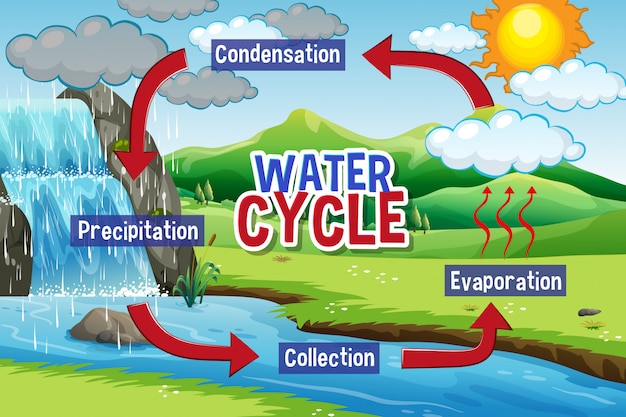Amazing Facts About the Water Cycle

The water cycle is a continuous process that keeps the Earth’s water supply in constant motion.
Water can exist in three states: solid (ice), liquid (water), and gas (water vapor).
The water cycle is driven by the sun’s heat, which causes water to evaporate from oceans, lakes, and rivers.
When water evaporates, it rises into the atmosphere and condenses into clouds.
Clouds are made up of tiny water droplets or ice crystals.
When the water droplets in a cloud become too heavy, they fall to the ground as precipitation.
Precipitation can come in the form of rain, snow, sleet, or hail, depending on the temperature.
About 90% of the Earth’s fresh water is stored in glaciers and ice caps.
Without the water cycle, there would be no rainfall or fresh water for plants, animals, and humans to survive.
The water cycle helps regulate the Earth’s temperature by distributing heat from the equator to the poles.
Once precipitation falls to the ground, it either soaks into the soil (infiltration) or flows into rivers and streams (runoff).
The speed at which water travels through the water cycle can vary from a few days to thousands of years.
Water molecules can stay in the atmosphere for an average of about nine days.
The water cycle is often referred to as the hydrological cycle.
The water cycle is essential for maintaining the balance of salinity (salt levels) in oceans.
Amazing Facts About the Water Cycle part 2
The water cycle is a global phenomenon that occurs in every corner of the Earth.
The amount of water on Earth has remained relatively constant for millions of years.
Water vapor is a powerful greenhouse gas that can contribute to climate change.
The water cycle can help disperse pollutants by carrying them from one place to another.
The water cycle is a natural filtration system that purifies water as it goes through various stages.
The water cycle can have different pathways in different regions, depending on the climate and geography.
Some of the water that falls as precipitation can seep deep into the ground and become groundwater.
Groundwater is an important source of fresh water for drinking, agriculture, and industry.
Some arid regions rely on underground aquifers to provide water in times of drought.
The water cycle plays a vital role in shaping and eroding Earth’s landscape over millions of years.
The water cycle can be disrupted by human activities, such as deforestation and pollution.
Climate change can affect the water cycle by altering rainfall patterns and increasing evaporation rates.
The water cycle is affected by weather patterns, such as hurricanes and tornadoes.
The water cycle is an intricate system that connects all living organisms on Earth.
Water is essential for all forms of life, and the water cycle ensures its distribution and availability.
The water cycle provides habitats for various aquatic animals and plants.
Water is a universal solvent, meaning it can dissolve many substances and transport them through the water cycle.
The water cycle can create beautiful natural phenomena, such as rainbows and waterfalls.
The water cycle can be studied and understood through scientific observation and analysis.
The water cycle is a constant reminder of the interconnectedness and interdependence of all living things.
The water cycle is an ongoing cycle of birth, death, and rebirth for water molecules.
Small-scale water cycles can be observed in our daily lives, such as the evaporation of water from a boiling pot.
The water cycle teaches us the importance of conserving and protecting our water resources.
The water cycle is a fascinating process that has intrigued scientists and researchers for centuries.
The water cycle can be visualized using diagrams and models to better understand its complexities.
The study of the water cycle is a crucial component of Earth science education.
The water cycle can influence weather patterns and contribute to the formation of storms and hurricanes.
The water cycle is a natural regulator of Earth’s climate and temperature.
The water cycle shows us the incredible power and resilience of nature.
The water cycle is a never-ending source of wonder and amazement for those who study it.

